Radiophysical methods in the study of physicochemical properties of liquids
Abstract
Relevance: The creation of new express methods for the qualitative and quantitative analysis of solutions and suspensions and biological liquids, as well as the development of technical means for their implementation, are urgent tasks in various fields of science and technology, in particular, in biotechnology and biomedicine. Also, the relevance of the work is due to the need to optimize technological processes for the production and synthesis of nanomaterials.
The purpose of the work is to verify theoretically and experimentally the possibility of using radiophysical methods to assess the physicochemical parameters of solutions and suspensions. Another purposes are optimization of the technological process of laser ablation and solution of the physicochemical problem of the synthesis of iron nanoparticles in magnetite shells.
Materials and methods: The paper presents a comparative analysis of methods for calculating the effective parameters of the system dielectric – metal inclusions using the mixing formulas of Maxwell–Garnett, Bruggeman and the finite element method. It is shown that in the case of metallic inclusions, the Bruggeman formula gives a more adequate result, which is consistent with the experimental results. The analysis of aqueous suspensions of metal nanoparticles was carried out by the method of impedance spectroscopy.
Results: A simple method has been developed for the synthesis of iron nanoparticles with a magnetite shell based on the reaction of controlled oxidation of iron nanoparticles by ozone. A microscopic analysis of the obtained particles was carried out and the rate of formation of the magnetic shell was determined. The method of impedance spectroscopy for measuring the concentration of metal nanoparticles in the process of laser ablation has been tested. It is shown that the state of sedimentation equilibrium of the suspension corresponds to a specific value of electrical conductivity.
Conclusion: It is shown that the method of impedance spectroscopy can be used as an indirect method for assessing the qualitative and quantitative physicochemical parameters of solutions and suspensions. The simulation of the influence of the distribution of metal particles in a dielectric matrix on the electrophysical parameters of the suspension is carried out.
Downloads
References
Faerber R, Franck C. Modular high-precision dielectric spectrometer for quantifying the aging dynamics in (Sub-)picofarad polymeric specimens. IEEE Transactions on Dielectrics and Electrical Insulation. 2018;25(3):1056-1063.
Cornelis P, Wackers G, Thomas I, Brand M, Putzeys T, Gennaro A et al. A Novel Modular Device for Biological Impedance Measurements: The Differential Impedimetric Sensor Cell (DISC). physica status solidi (a). 2018;215(15):1701029.
Impedance Analyzers | Keysight [Internet]. Keysight.com. 2020 [cited 19 December 2020] Available from: https://www.keysight.com/en/pc-1000000382%3Aepsg%3Apgr/impedance-analyzers?nid=-33831.0.00&cc=UA&lc=eng
Impedance Products | Zurich Instruments [Internet]. Zhinst.com. 2020 [cited 19 December 2020]. Available from: https://www.zhinst.com/others/en/impedance-products
Wayne Kerr Electronics Products - 6500B Series Impedance Analyzer [Internet]. Waynekerrtest.com. 2020 [cited 19 December 2020]. Available from: http://www.waynekerrtest.com/products_detail.php?indexs=4&brand=Wayne%20Kerr
Kozheshkurt V, Antonenko Y, Shtoda D, Slipchenko O, Katrych V. Possibilities of Impedance Spectroscopy for the Study of Bioliquids. 2018 9th International Conference on Ultrawideband and Ultrashort Impulse Signals (UWBUSIS). 2018:280-284.
Fernandes C, Mello M, dos Santos N, Souza A, Lanznaster M, Ponzio E. Theoretical and experimental studies of a new aniline derivative corrosion inhibitor for mild steel in acid medium. Materials and Corrosion. 2019;71(2):280-291.
Cheng X, Liu Y, Irimia D, Demirci U, Yang L, Zamir L et al. Cell detection and counting through cell lysate impedance spectroscopy in microfluidic devices. Lab Chip. 2007;7(6):746-755.
Bao X, Ocket I, Bao J, Doijen J, Zheng J, Kil D et al. Broadband Dielectric Spectroscopy of Cell Cultures. IEEE Transactions on Microwave Theory and Techniques. 2018;66(12):5750-5759.
Masot R, Alcañiz M, Fuentes A, Schmidt F, Barat J, Gil L et al. Design of a low-cost non-destructive system for punctual measurements of salt levels in food products using impedance spectroscopy. Sensors and Actuators A: Physical. 2010;158(2):217-223.
Yang S, Hallett I, Oh H, Woolf A, Wong M. Application of electrical impedance spectroscopy and rheology to monitor changes in olive (Olea europaea L.) pulp during cold-pressed oil extraction. Journal of Food Engineering. 2019;245:96-103.
Lau M, Ziefuss A, Komossa T, Barcikowski S. Inclusion of supported gold nanoparticles into their semiconductor support. Physical Chemistry Chemical Physics. 2015;17(43):29311-29318.
Tran H, Matsumoto K, Moriya M, Shimada H, Kimura Y, Hirano-Iwata A et al. Fabrication of high temperature capacitively- and resistively-coupled single electron transistors using gold nanoparticles. 2016 IEEE 16th International Conference on Nanotechnology (IEEE-NANO). 2016:131-134.
Skotadis E, Mousadakos D, Tanner J, Tsoukalas D, Broutas P. Flexible platinum nanoparticle strain sensors. 2013 Proceedings of the European Solid-State Device Research Conference (ESSDERC). 2013:354-357.
Koch L, Sajti L, Schwenke A, Klein S, Unger C, Gruene M et al. Laser-based micro- and nanofabrication for applications in biomedicine. 2012;1464(1).
Kobayashi T. Cancer hyperthermia using magnetic nanoparticles. Biotechnology Journal. 2011;6(11):1342-1347.
Silvestr P, Ferrari R. Finite elements for electrical engineers. M: Mir; 1986;229. [In Russian].
Antonenko Y, Kozheshkurt V, Shtoda D, Katrich V. An amplitude and phase detector for dielectric spectroscopy systems. Radiophysics and Electronics. 2020;25(3):68-77. [In Ukrainian].
Liu F, Laurent S, Roch A, Vander Elst L, Muller R. Size-Controlled Synthesis of CoFe2O4Nanoparticles Potential Contrast Agent for MRI and Investigation on Their Size-Dependent Magnetic Properties. Journal of Nanomaterials. 2013;2013:1-9.
Proenca M, Sousa C, Pereira A, Tavares P, Ventura J, Vazquez M et al. Size and surface effects on the magnetic properties of NiO nanoparticles. Physical Chemistry Chemical Physics. 2011;13(20):9561-9567.
Lacroix L, Malaki R, Carrey J, Lachaize S, Respaud M, Goya G et al. Magnetic hyperthermia in single-domain monodisperse FeCo nanoparticles: Evidences for Stoner–Wohlfarth behavior and large losses. Journal of Applied Physics. 2009;105(2):023911.




